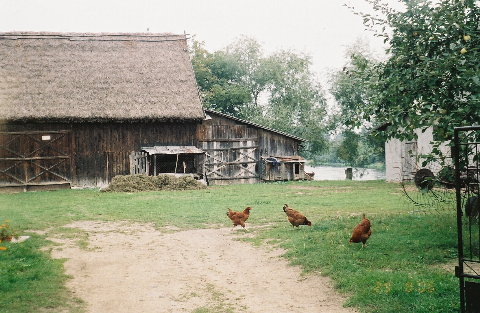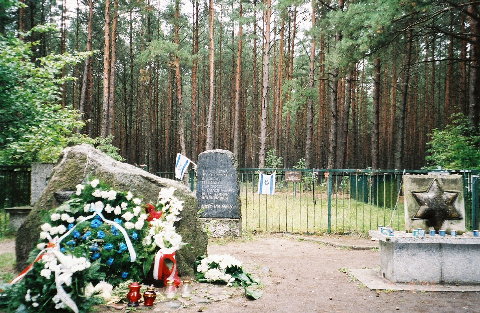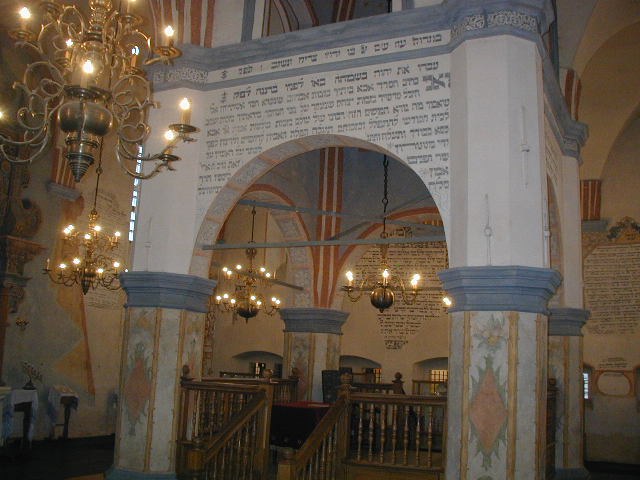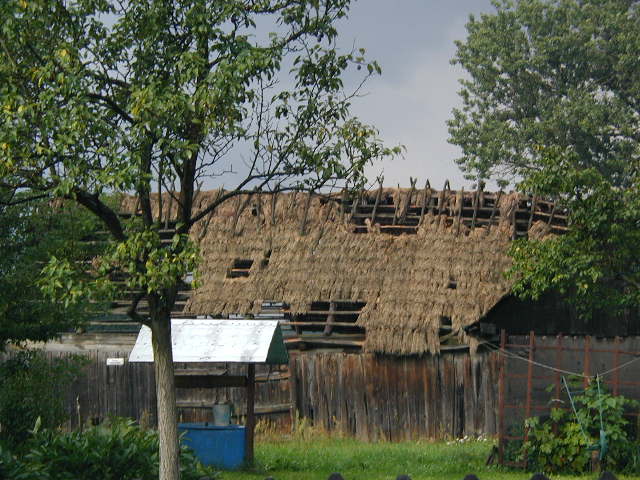
After breakfast, we set out to northeastern Poland. Uncle Murray's passport had been issued in Pultusk in 1920, so that was the first town we went to. Just before the town, there's a large lake where the Narew and Bug rivers meet at a dam. Pultusk also supposedly has the largest town square (actually, town rectangle) in Europe. By the way, Murray's American visa was issued in Gdansk and Tomasz speculated that he would have traveled there entirely by boat, along the Narew, Bug, and Vistula.
But the family residence was actually in the town of Zambsk-Koscielsse in the district of Obryte. I think our driver (and Tomasz, who was navigating) were relieved to find the turn-off for Zambski not long after we passed through Obryte. We drove through Zambsk Stare (Old Zambsk), which consisted of two houses. Zambsk-Koscielsse proved to be a bit larger, with maybe 20 houses. There was also a church (restored in 1959) and a priest's house across the street from it. Most of the town consisted of wood houses, fruit trees, and poultry (chickens and roosters), with a large stork's nest and a path down to the River Narew. All in all, that made for a picturesque rural village, which was more or less what Mom expected it to look like.

By the way, it's obvious that they don't get many outsiders in this region and we were very definitely stared at. Tomasz tried to talk to one of the locals and was completely ignored.
We continued on to Lomza, which is the largest town of the region and which holds the archives I had previously ordered various records from. On the way, we passed through a large forest of birch trees. A lot of people gather mushrooms in the forest and sell them on the side of the road. We didn't actually stop at the archives, but did pass them, the local bus station, and a MacDonald's, which prompted me to declare that Lomza must be an actual city and not just a town. We ate our light lunch, however, at a hotel coffee shop. After eating, we visited two Jewish cemeteries. The first was notable for unusual tombstones, in the shape of mushrooms. The primary distinction of the second was the difficulty we had in finding it.
My grandfather was from further east, so we continued on to Tykocin (Tiktin or Diktin in Yiddish). We stopped at a spot in the forest where almost 3000 Jews (more or less the entire population of Tykocin) were shot by the Nazis. There are three mass graves and numerous memorials in the form of names tied to the fences.

Tykocin itself has a famous and beautiful synagogue, with Hebrew and Aramaic verses painted on the walls.

The synagogue is now a museum and has display cases with various types of ritual objects. What had been the women's section has displays with photographs of Tykocin residents. I was rather rushed looking through them because Mom was feeling a bit unwell, but I didn't see any family names I could recognize or faces that looked particularly familiar.
We continued on to a small town called Chobotki, which could be where the family was from. (That's speculation based entirely on similarity to the original family name, so it's hard to say.) The district looked more prosperous, with larger farms and nicer houses than Mom expected. But there was this run-down structure, which I immediately proclaimed was obviously the ancestral mansion.

Mom was fairly worn out and napped during most of the two hour drive back to Warsaw. (She revived enough for dinner at a cafe near our hotel but went to sleep earlier than usual.) All in all, I'd say she was reasonably pleased with the excursion, although she would also have liked to have found out something about her great-grandmother, who was an abandoned infant, adopted after being left on a doorstep. I consider that pretty much a dead end of genealogical research and not even worth an attempt. As for me, I thought this was the most interesting part of the trip, even if it confirmed my belief that I come from humble roots. But we still had plenty of other things to see in Poland, albeit ones which had nothing to do with our family.
[Back to Last Chapter | On to Next Chapter | Back to Index]
Copyright 2006 Miriam H. Nadel
last updated 5 November 2006